Grand Tour of the Eastern Sierra
Eight Days of Climbing with AAI in the "Range of Light"
Text and Photos by Zac Merriman
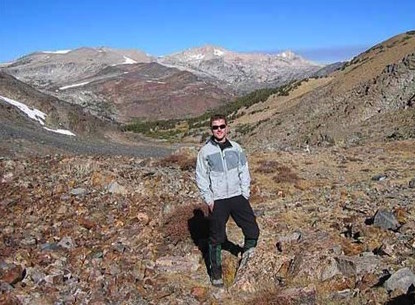
Zac on the approach to Dana Couloir
I have wanted to climb mountains ever since I got my first taste of it on an Outward Bound course in the Oregon Cascades ten years ago. Sure, I've had my fair share of hiking and even a little rock climbing, but what I wanted was to climb mountains. Several climbing courses that I have scheduled over the past few years have disappeared before my eyes, either because a friend bailed at the last minute or because work came up. However, last summer I finally had enough of this and decided, no excuses, that I was going to learn to alpine climb.
My first step towards this goal was to sign up for an Sierra Mountaineering and Leadership Course in the Eastern Sierra with AAI. I had fun preparing for this course and meticulously researched all the gear I was going to need - even procuring an ice tool (who knew there were "glaciers" in the Sierras?). I'll save the details of that course for a different trip report, but the gist of it is that climbing the Swiss Arête of Mt. Sill during the course was one of the most exhilarating experiences of my life. It was my first multi-pitch rock climb, and I was both invigorated and freaked out by the experience. After the course ended and I had been back in civilization for a few days, all I could think about was getting back out to the mountains and climbing some more.
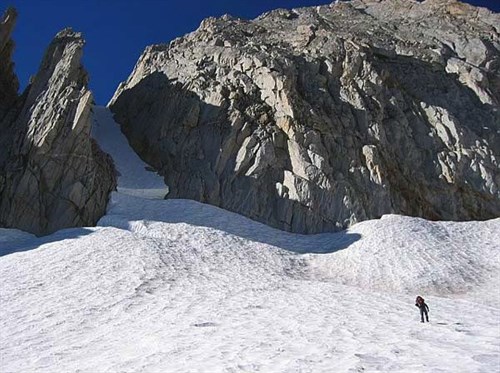
Dan on the approach to the North Couloir of North Peak
Once again, I decided to take action. I called up Coley at AAI and asked him if Dan Shuteroff, my instructor/guide on my previous course, was available for another trip to the Sierra in late September. I was interested in the Palisade region of Kings' Canyon and wanted to tackle some of the fabled ice climbs there. I figured that since Dan and I got along so well in such close quarters for 9 days, we might be a good team for future climbs. That and he is so incredibly passionate about climbing and teaching that one cannot help but be inspired and energized by his infectious enthusiasm. Basically, he's a hell of a guide. Anyhow, I got the green light from the AAI administrative office, and Dan and I met at Tioga Pass on September 19th and started climbing the next day.
Dan had learned that the ice conditions in the U-Notch and V-Notch were less than ideal - i.e., there was no ice there - so we had to come up with a different itinerary. We left it fairly open-ended, with the one sure thing being that we would climb the Venusian Blind Arête on Temple Crag on the 23rd. Given that I had limited ice experience (I had stuck my tools into the Palisade Glacier a few times where it fell into a lake at its terminus), we decided on a teaching/climbing day on the Northeast Couloir of North Peak, a very close neighbor of Mt. Conness, just outside of Yosemite National Park.
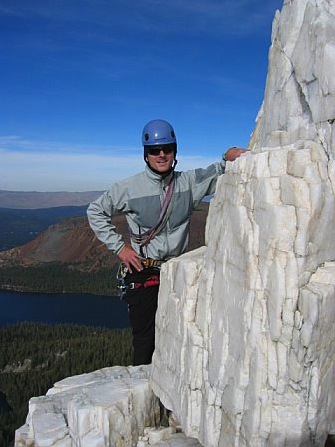
An amazing quartz crystal band on Crystal Crag, near Mammoth
We had a leisurely start at 7am and began the approach hike, skirting the shore of Saddlebag Lake and then weaving in and out of various other lakes on the east side of Conness. After climbing up some mossy ledges, we arrived at the snowfield at the base of the climb and donned our crampons. The snow was rock hard - what Dan called perfect neve - and I just knew it was hard enough that I definitely wouldn't have wanted to go very far on it without spikes. We spent a lot of time practicing alpine ice climbing, going through the crampon techniques (pied en canard to pied troisiemme to frontpointing), as we had a perfect practice bergschrund about twenty yards from the real one. Then we practiced placing the tools and actually climbing on the 'schrund. It was a perfect learning environment, because I could climb up the 'schrund, then walk back down and do it again.
The day was getting on, so we decided it was time to climb. I believe it was four pitches to the top of the couloir, with Dan setting up anchors in the moat on the right side of the couloir. The neve was truly perfect, and Dan must be a terrific teacher, because I didn't so much as slip on the way up. After the couloir, we left our gear and climbed the fourth class granite to the summit. North Peak actually has a very cool summit pyramid when viewed from the south, and though it's overshadowed by the more famous Conness, it's a fantastic climb. After hanging out on the summit for a little bit, we down-climbed back to our gear and then descended the southwest side of the mountain, hiking down over nice grippy granite slabs. It was nearly dark by the time we were back at Saddlebag Lake, and I was pretty tired, but what a climb! We went back to the campground by Tioga Pass, and after eating some freeze dried food and downing two liters of water, I passed out.
The next day we decided to climb Crystal Crag, a pretty mellow day after the ankle torquing affair on North Peak the prior day. I spent the morning setting anchors for Dan to inspect, and he critiqued my cam and nut placements, showing me how a slightly different location or orientation made for a stronger hold. After several hours of this, we climbed the North Face of Crystal Crag, which is either a really easy 5.8 or a moderate 5.7. This is a great little alpine climb right outside of Mammoth Lakes, and the views from the climb are beautiful. Once we reached the top of the climb, the reason for the name became obvious, as there's a giant quartz formation at the top of the face. It's perfect white quartz, and it reminded me of the original Superman movie, during which one sees the planet Krypton in its crystalline glory. The only thing missing was Marlon Brando's voice and apparition. Maybe next time. On the descent, Dan had me simulate an emergency rappel scenario, and I set up a rappel anchor while hunched underneath a tree on a dirty slope. He said, "Imagine it's raining, and there's lightning, and your partner freaks out, and you need to get him down fast." I was so uncomfortable under that tree, slipping in the dirt, that I had an easy time imagining the conditions were deteriorating, but I set the anchor rapidly and rappelled down the rest of the route. I gave Dan a fireman's belay as he rapped down too, and then he did a "Batman" to get back up the rope and disassemble the anchor. This was a great way to add some extra instruction and practice to a mellow climbing day.
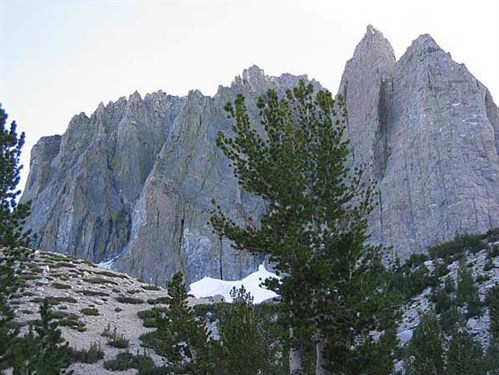
View of Temple Crag from camp at Second Lake
On day three, we headed down to Bishop for some last minute supplies and then drove to Big Pine, where we parked and hiked into our camp at Second Lake, below the base of Temple Crag. I had seen this behemoth on our trip back in June, with its flying buttresses and incredibly exposed arêtes. The Venusian Blind Arête dwarfs the Swiss Arête of Mt. Sill. Dan went up to the base of the climb to chop steps for us, as we had both hiked in with approach shoes on. We kept it extra light, and I slept in a bivy sack, while Dan used his pack for his bivy. After an early dinner of split pea soup and tuna fish (awesome combination), I slept like a baby, waking at 4:30am for our climb. The Venusian Blind is a good 13 pitches long, so we were going to have a long day.
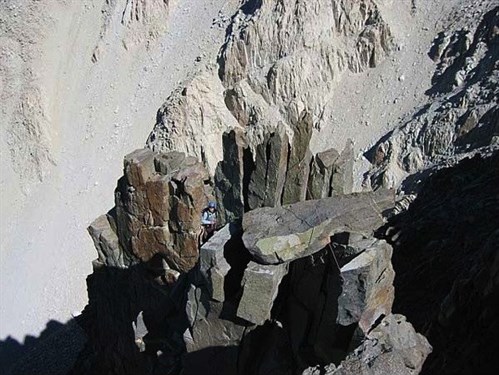
A tricky, exposed traverse on the Venutian Blind Arete
We left camp at 6am, and we were on the route around 7am. The overnight temps were below freezing, and it wasn't much warmer at dawn, so the first part of the climb was pretty chilly. As we moved around the arête, it felt like we were chasing the sun and its warmth. The gully on the right side of the arête was particularly cold, and sensing that my hands were getting chilled on the belays, Dan enabled us to simul-climb about 400 feet of the route. When we entered into the sun for good, it was wonderful. The rock warmed up, the day was clear, and the climbing was superb. There was only one other party on Temple Crag that day, but they were on Dark Star, so we didn't see them until we met at the rappel station at the end of the day. We reached the top of the arête, and there was some wild scrambling, including a down-climb and a step-across over huge air. Some of these moves were as exhilarating as the actual climbing. Once on the summit, around 3pm, we had tremendous views of Middle Palisade, Norman Clyde Peak, Mount Gayley, Mount Sill, and the striking arêtes of Temple Crag. One in particular looked very cathedral-like, and it cast a shadow that looked like a gothic cathedral itself. We signed the summit register, and Dan noticed that one of his former girlfriends had signed the register earlier in the summer. Small world.
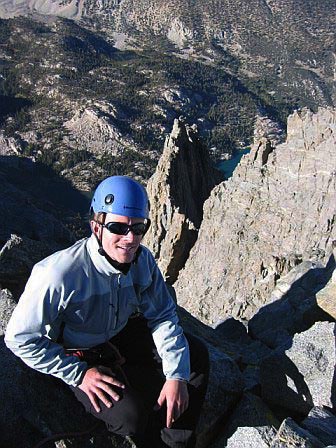
Zac on the summit of Temple Crag
It was time to descend, and once we were a few hundred feet below the summit, I began to appreciate how fleeting that summit moment can be. One minute I'm on top of the world, reveling in the accomplishment of climbing a 5.7, 13-pitch route. The next minute, my head has to be back in the game for the descent, because Dan says the climb is not over until you are back in camp with your boots off. So, we down-climbed a long way to the rappel station, then made two rappels to get to the col that led back to camp. We exchanged pleasantries with the Dark Star crew, and then it was all business as we had to race nightfall to get back to camp safely. The rappels were the easy part, because the scree and talus that greeted us at the col were pretty heinous. We hopped giant talus, surfed down quicksand-like scree, and had to cross a snowfield a few times. Fortunately the scree had penetrated the snowfield, which provided a lot of traction. It happened to get dark enough for headlamps right as we exited the scree and talus, and we had an easy jaunt back to camp with the assistance of LEDs. I decided it was too dark and I was too tired to hike out, so we stayed one more night.
The hike out the next morning was mellow, and after one more re-supply and beta check in Bishop, we went to the Rock Creek area, thinking we would do some cragging over the next two days. We camped at Iris Meadow and climbed that afternoon at Iris Slabs. We ran into another AAI instructor, Dawn Glanc, and her three students. Dan set up a top rope on a 5.5 climb, and he had me climb it several times. I must have climbed that route five or six times. The next to last time, I climbed on top rope but dragging a lead rope to practice leading. The final trip up, I led the climb without the top rope and made it a two-pitch climb to get the experience of establishing an anchor on the route. I belayed Dan up, learning that if the power point of the anchor is too close to my waist, I end up belaying with alligator arms. That said, I got him up, clipped him in, and then we finished the climb. I was pretty cooked after the last few days, so we headed back to camp, which was about a five minute walk away. Iris Slabs was a great spot!
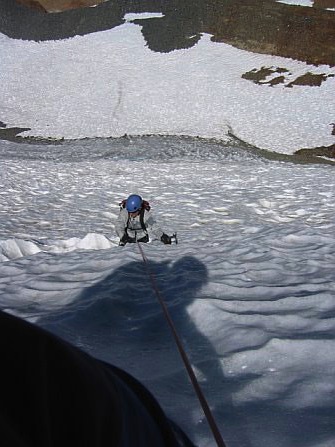
Zac tackling the overhanging edge of a bergschrund in the Dana Couloir
I had procured some soy milk in Bishop, so for the next few mornings, I would be eating Grape Nuts with soy milk, and this made me so happy I could barely contain myself. I must have told Dan at least five times how great it was to have soy milk, and he must have thought that I was crazy. The next day, we went climbing at Owens River Gorge, a basalt climbing mecca for the Bishop area. We hiked down into the gorge, and Dan led a 5.8 and a 5.9, and I attempted to climb them on top rope. My body was a little worked after the speed laps on Iris Slabs, so my climbing was a little sub-par on this particular day. We made tape gloves and spent a lot of time working on crack climbing technique on a few man-eating cracks. I made it up the 5.8 with one aid move, making a stirrup from a double length runner. I thought this up all on my own! I can't remember if there was a French free move in there as well, but sometimes it's just about getting up. I didn't fare so well on the 5.9, as the crux roof at the beginning of the climb was a pretty difficult move for me. We called it a day and headed up to Tioga Pass again.
One of the conundrums presented by having such a flexible schedule with this trip was that we could do whatever we wanted to on a given day. This was good because of the many quality options, but it was also a challenge to narrow down the opportunities. On the drive up to Tioga, I was waffling back and forth between wanting to do another snow/ice route or another rock route. As I got to the Mobil station in Lee Vining, home of the $20 quesadilla, and I stared up at the snow and rock on the edge of Yosemite, I decided we should do another ice climb.
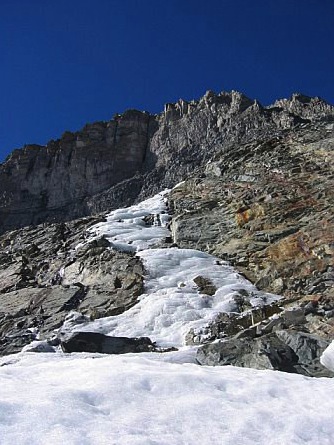
A small ice flow near Dana Couloir that we climbed for a laugh
We camped at Tioga Lake the next two nights, and the next day, we climbed Mt. Dana via the Dana Couloir. This was a mellow approach, following a creek to a crystal clear, sapphire blue lake at the base of the couloir. There was a frozen waterfall on a rock outcropping that presented a terrific practice area for mixed climbing. Dan led up the "mixed" route, and I followed, dropping my first piece of ice protection. Fortunately, this happened in a very confined area, and Dan was able to recover the ice screw. That won't happen again. The conditions on Dana were much icier than the neve on North Peak. There was bullet hard blue ice on this route. We climbed up to the bergschrund, discovering that it was a good 15-20 feet high and overhanging over its entire length. Dan led this pitch, obviously, sending me down his ice tool so that I would be swinging two tools, rather than a tool and an axe. This part of the climb was amazing. The picks sank in and gained great purchase in the ice, and my crampons held securely. Dan snapped a few pictures of me coming out of the schrund, and I felt like I was making great progress. I led two pitches on this climb, placing the screamer early in each pitch, and placing the ice screws in some incredibly secure blue ice. This was an awesome feeling. Two days before, I was leading my first rock climb, and here I was leading on alpine ice. Sure, it was only 45 to 50-degree ice, but it was ice nonetheless.
Dan led the remainder of the climb, and since we could see bad weather moving into the Mammoth and Cathedral Lakes areas south of us, we hightailed it to the summit over some wildly colored green choss. The summit view was tremendous, as we could see the storms to the south and the mountains to the north, particularly North Peak and Mt. Conness. We descended through more hideous green choss, and when we reached the trailhead on Tioga Road, I think we were both pretty beat. It had been a hell of a week. Dan knew my energy was flagging, but we had one more day to climb so we hurried back to camp, and he boiled some water immediately. He gave me a hot water bottle to put in my parka, and I couldn't get over how long that bottle stayed hot. I think that night I had lentils and tuna fish, and I confirmed for myself that I prefer lentils over split pea soup. I took down two bottles of water in preparation for one more day of climbing.
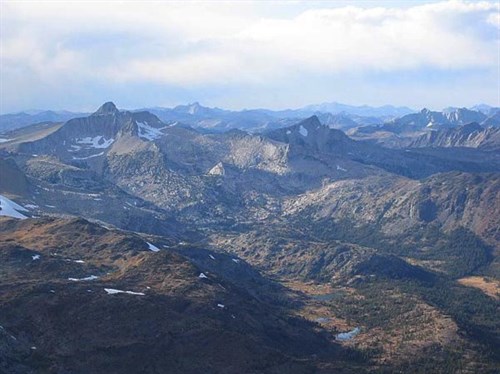
Zac on the approach to Dana Couloir
On the final day, we climbed the North Ridge of Mt. Conness, which involved a very similar approach to North Peak, some very exposed and wonderful ridge climbing, and another long descent. This was a great way to end an amazing trip. I must say though, the trip really came full circle the day before on Mt. Dana. I knew that I loved climbing alpine rock, but I didn't know how I would feel about the ice climbing - it turns out that I love that, too!
In all, Dan and I had a very full trip. By the end of the trip, it felt like we were not only teacher and student, but also climbing partners and friends. As I said earlier, Dan's boundless energy, infectious enthusiasm, and deep knowledge of climbing make him a truly special and gifted guide. I am grateful to him for our experiences together, and I look forward to climbing with him in the future. Thank you Dan, and thank you AAI!
Click the link to see American Alpine Institute's 12-day sierra alpine climbing course.
Program Finder